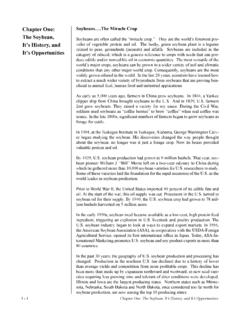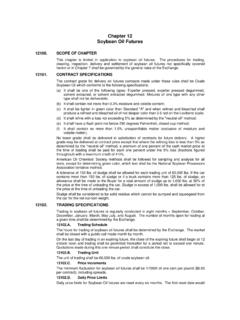Transcription of Soybean Cyst Nematode Management GUIDE
1 SCN Soybean cyst NematodeManagement GUIDE FIFTH EDITIONSCN remains the most important threat to Soybean profitability in North America. Your Soybean checkoff. Delivering of Contents 4 How important is SCN?5 What is SCN?6 How does SCN affect Soybean ?7 Does SCN interact with other diseases?9 What does SCN damage look like?10 Soil sampling for SCN12 Why are SCN numbers variable?12 What are HG types?13 Minimizing SCN impact on yieldYour GUIDE to managing SCN- infested fields for increased yield and an increased bottom line! This publication was developed with you, the Soybean grower, in mind. Included in these pages are the answers to frequently asked questions, along with recommendations based on decades of research on Soybean Management in SCN-infested fields. This research has shown that soybeans can be produced profitably in spite of SCN.
2 The first move is yours; to determine whether you have SCN infestations, then tailor a Management strategy for your farm. We hope the following sections will be useful to Soybean cyst NematodeManagement GUIDE FIFTH EDITION2 SCN Management GUIDE If you think you don t have SCN, you should read this GUIDE . You could have it and not know it. If you know you have SCN, there may be more you can do to improve Soybean profits. DO YOU KNOW?3 Soybean cyst Nematode (SCN) is the leading cause of Soybean yield loss in North America. SCN symptoms are NOT unique or diagnostic; they may look like those due to many other causes. SCN is not always visible on roots of infected plants. SCN can cause substantial yield loss without causing cyst Nematode (SCN), or Heterodera glycines, is the most destructive pathogen of Soybean in North America.
3 Soybean producers in the United States lost more than 300 million bushels to the Soybean cyst Nematode from 2003 to 2005. More yield is lost to SCN than any other Soybean pathogen. At present, soybeans are planted on more than 70 million acres in North America. SCN is widely distributed in all major Soybean production areas of the United States (see map, right). SCN was first found in the Western Hemisphere in North Carolina in 1954. Before then, SCN was known in China, Japan and Korea. The nematodenow occurs in all major Soybean production areas worldwide, including both North and South Nematode may have been introduced into the United States several times during the late 1800s in soil imported from Asia for the purpose of obtaining bacteria to nodulate Soybean roots. SCN can be spread by anything that moves soil: wind, water, animals (especially birds) and the economic impact of SCN is difficult because many producers suffer declining yields for several years without knowing that they have SCN.
4 Planting the SCN-resistant variety Forrest in the southern United States on farms with known SCN infestations prevented $401 million in crop loss during 1975-1980, while the cost of developing Forrest was less than $1 million. SCN is much more widespread today, and SCN-resistant varieties prevent even more crop Symptoms SCN-resistant and -susceptible varieties growing side-by-side in a heavily infested Soybean field. There is no way to tell which is which by looking at the plants. In this field, the resistant variety yielded over 30 percent more than the susceptible. Map Distribution of known Soybean cyst Nematode infestations in the United States in 2008. (Riggs and Tylka)1. How important is SCN and where does it come from?4 SCN Management GuideSCN, like all plant-parasitic nematodes, is a microscopic roundworm a very simple animal, related to the animal-parasitic roundworms that infect livestock and pets.
5 The juvenile Nematode [top right] is the infective stage of SCN the stage that actually enters the Soybean root. It hatches from an egg [right].The juveniles penetrate Soybean roots and cause the for-mation of specialized feeding cells in the vascular system (veins) of the roots. If the juveniles become males, they leave the root after feeding for a few days, move through the soil, and do not contribute further to plant damage. If the juveniles become females, they lose the ability to move and swell into lemon-shaped objects as they ma-ture. Females become too large to remain completely embedded within the root. Their heads remain embedded while the rest of their bodies break out of the root [young female, right]. The young adult female is referred to as a white female. Plant damage is primarily due to the feeding of females and the indirect effects of such females become yellow as they age and then turn brown after they die [right].
6 The brown stage is the cyst for which the Nematode is named. Each cyst can contain up to 500 eggs [lower right], but under field conditions they usually contain many fewer eggs. The cyst protects the eggs from the harsh soil environment, helping them to persist for years in a dormant can theoretically complete up to six generations during the growing season, depending mainly on: Host suitability Geographic location Length of growing season Planting date Presence of weed hosts Soil temperatureJuveniles Juvenile (infective stage) SCN after hatching. The nematodes are about 1/64-inch long, invisible to the unaided Egg The juvenile worm can be seen folded up inside. (M. Mota, Universidade de Evora, Portugal)SCN Cysts SCN cysts of different ages: white females are young, yellow to brown females are older and dying or dead.
7 2. What is SCN?5 SCN Management GuideBroken cyst A dark brown cyst , broken open to reveal the eggs and juvenile nematodes within. (E. Sikora, Auburn University)Young Female A maturing SCN female, too large to be contained within the root. (T. Jackson, University of Nebraska)SCN-infected roots on right are stunted, discolored, and have fewer nitrogen-fixing nodules than noninfected roots on cannot reproduce without a host plant. Conditions that favor Soybean plant growth are favorable for SCN effect of SCN on Soybean growth and yield in-volves several mechanisms, all of which are directly related to the numbers of nematodes feeding on the root system: plant nutrients are removed, nutrient and water uptake in the roots are disrupted, and root growth is retarded. SCN infection may also reduce the number of nodules formed by the beneficial nitrogen-fixing bac-teria that are necessary for optimum Soybean growth [below].
8 Plants infected with high numbers of SCN have poorly developed root systems that cannot utilize nutrients and water efficiently. The result may be stunted plants with chlorotic (yellow) foliage. More frequently, however, no obvious symptoms are produced. This is especially true for production fields from Kentucky northwards. In fact, scientists throughout this region have observed many research trials in which resistant and susceptible Soybean varieties show no consistent differences in plant growth; in other words, they could not be distin-guished visually [center right]. On the other hand, the yields of resistant varieties were consistently higher than those of the susceptible varieties, as in the exam-ple [lower left]. With or without visible symptoms, seed yields are low because fewer pods develop on infected plants.
9 SCN infections by themselves do not reduce seed size, number of seed per pod or seed TrialA Soybean variety trial planted with SCN-resistant and suscep-tible varieties, in a field infested with 10,000 SCN eggs/100 cc soil, high enough to reduce yields by 50 percent or more. There is no visual evidence of the stunning yield loss suffered by the sus-ceptible varieties. (T. Jackson, University of Nebraska)6 SCN Management Guide3. How does SCN affect Soybean ?Yield Trial Results The bars in this graph show Top 10 comparisons: yields of the 10 highest-yielding SCN-resistant varieties compared with the 10 highest-yielding susceptible varieties in three central Illinois loca-tions in 2006 variety trials. All three locations were infested with moderate SCN population levels. Soybean yield (bu/A)757 0 6 5 6055 Monmouth Goodfield Dwight Top 10 Resistants Top 10 Susceptibles 716366596368It is common for other Soybean patho-gens* to be present in SCN-infested fields and for interactions among the pathogens to occur.
10 Infection by SCN juveniles and the eruption from roots by the maturing females create openings in the root surface that can serve as entry points for other soil-borne Soybean pathogens such as Pythium, Rhizoctonia, Phytophthora, Fusarium (the cause of sudden death syndrome, Fusarium wilt, Fusarium root rot) and Macrophomina (the charcoal rot pathogen).SCN and SDSSCN is involved in the development and spread of sudden death syndrome (SDS). The fungus that causes SDS (Fusarium virguliforme) lives in the soil with SCN and is fully capable of causing disease on its own, but research has shown that SCN hastens the development of SDS symp-toms and increases their severity, leading to greater yield Interactions A row of Soybean plants affected by SCN, charcoal rot and potassium deficiency, all at the same time.









